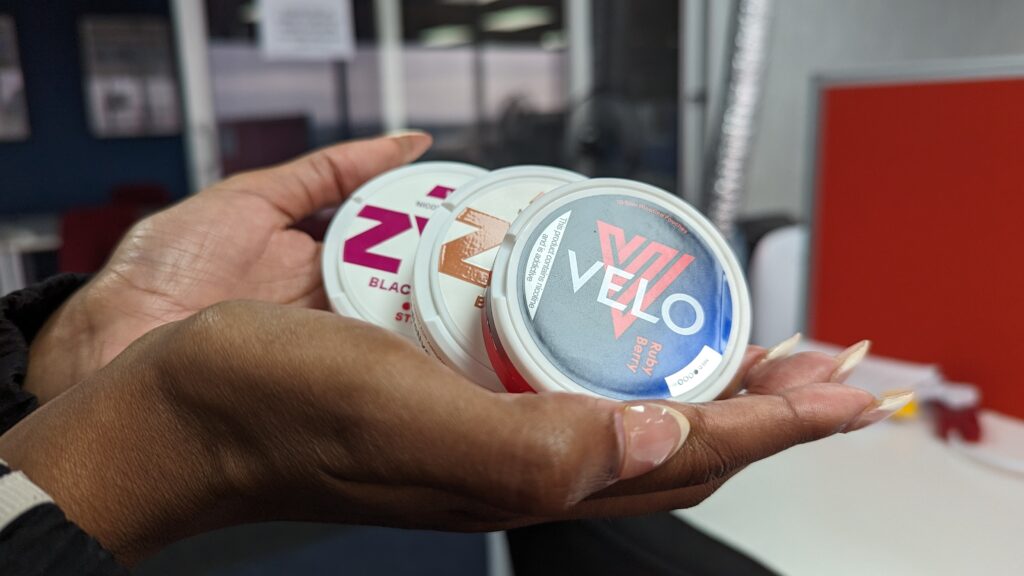- Nicotine pouches (or “upper deckys”) are getting more and more popular, with 6.8-billion units sold worldwide in 2021.
- With tobacco sales struggling under stricter regulations across the world, Big Tobacco markets nicotine pouches as aids to help people quit smoking, despite questionable comparisons to nicotine replacement therapy products.
- In fact, nicotine pouches have been criticised for worsening nicotine addiction, a ploy by the tobacco industry some say to exploit legal loopholes and target young people through aggressive marketing — sparking concerns about their safety.
In today’s newsletter Christina Pitt explains why nicotine pouches won’t help smokers quit. Sign up.

Ever heard of “upper deckys” or “Zynbabwes”?
That’s what some nicotine pouches — small, meshy sachets that contain powdered nicotine and flavourings — are called on social media. And they’re all the rage at the moment.
Tucked under the lips of athletes, media personalities like podcast host Joe Rogan and Swedish influencers, nicotine pouches have become so popular that 6.8-billion units were sold worldwide in 2021.
With rules about selling tobacco having become stricter across the world, including in South Africa where an update to tobacco legislation will ban smokes and vapes from being sold from vending machines and being shown at tills, it’s not surprising that Big Tobacco is looking for other ways to reel customers in.
And what’s better than masquerading a pocket of nicotine, like Velo by British American Tobacco (BAT) or Zyn by Philip Morris International (PMI), as a tobacco-free product that will help you quit smoking — especially since there isn’t much support to help current smokers quit?
In 2021 alone, close to 4.5-million smokers in South Africa tried to quit. But the odds aren’t good: studies show that without getting help from medicine or nicotine replacement therapy (NRT) like patches, gum or lozenges, most people reach for a cigarette again within eight days after they vowed to stop.
This is concerning as, back in 2016 already, 26 000 people died from smoking-related diseases like cancer and heart and lung diseases in the country, costing the government over R42-billion in healthcare expenses and lost productivity.
But a nicotine pouch is not the same as a patch that will help you kick smoking in the butt. Here’s why.
How does a patch full of nicotine help you get off nicotine?
Smoking is addictive because tobacco contains nicotine, a chemical that latches onto nerve cells in your brain once you inhale it from a smoke and causing the feel-good hormone dopamine to be released. This kicks your brain’s reward system into action, making you want more of that satisfied feeling.
The longer you smoke, though, the more places your brain cells create for nicotine to bind — and each one craves its fix. This means the longer you smoke, the more you need to smoke to keep feeling good. When you stop feeding the habit, your brain doesn’t release the amount of dopamine it was used to getting, and you start feeling grumpy, irritable, depressed and restless — some of the typical withdrawal symptoms smokers trying to quit experience. Not wanting to feel like this, you reach for the smokes again — which keeps you locked in to the addiction.
The good news is that when your brain gets used to being without nicotine, the extra places where it used to bind on your nerve cells start disappearing, and so they reset to their pre-smoking state.
This is where nicotine replacements like patches, gums or lozenges come in: they still give your body its fix, but because you gradually use lower-strength products, your cravings become less intense over time and you slowly wean your brain off the stuff.
The dosage of nicotine you need from replacement therapy depends on how addicted you are to the substance in the first place, which can depend on things like how long you’ve been smoking, genetic factors or your age. A health worker can run through a simple questionnaire that asks how many cigarettes you smoke a day and how soon you need to smoke after you wake up.
The higher your score, the more dependent you are and the higher the initial dosage should be when you start replacement treatment. For example, nicotine patches come in strengths of 5–52.5mg, which is slowly taken up through the skin over the course of a day. People who are heavy smokers (typically smoking 10 or more cigarettes a day) are usually advised to choose a high-dose patch to start with. The strength is then adjusted in a controlled way over several weeks, until you don’t need nicotine anymore.
Studies show that getting help from NRT, ups someone’s chances of quitting for good by 50–70% over trying to go cold turkey.
So, can’t you get the same result from sucking on a nicotine pouch?
Pouches and patches aren’t peas in a pod
Big Tobacco would like people to think so, and punts nicotine pouches as a form of harm reduction (things you can do to reduce bad health effects) by saying that these products are a less risky alternative to cigarettes.
But they’re twisting the facts.
In a study funded by PMI-owned tobacco company Swedish Match, the authors comment that gum with a total of 6mg of nicotine released more of the substance into the blood than what they found for Zyn pouches of the same strength. Other industry-funded researchers hopped on board and referenced this study in 2021 as evidence that nicotine pouches are as good as — or better than — NRT. A year later, a study funded by a BAT-linked company in Canada compared the effects of same-strength nicotine pouches, lozenges and gum and found that users get a similar fix from sucking on a lozenge or a pouch, but more than from chewing gum.
Nicotine pockets like BAT’s Velo or PMI’s Zyn are sold at strengths of between 3mg and 10mg each, with between 10 and 15 in a tin. A cigarette, in contrast, delivers about 1.5mg nicotine per stick.

However, nicotine takes longer to reach your brain when it has to move through the moist lining of your mouth and from there into your blood — about 30 minutes — than when you inhale it from smoke, which takes about 15 seconds. This slower uptake, an independent study shows, may be why people trying to stop say the gum or lozenges don’t relieve their craving like a cigarette does — and why tobacco companies would like to punt the pouch as NRT while it actually just tricks users into reaching for a smoke.
“It is very possible that people may end up using both nicotine pouches and cigarettes and use more [nicotine in the end],” says the study’s lead author and cancer researcher at Ohio State University, Brittney Keller-Hamilton.
Of the 315 people aged between 15 and 24 surveyed in the US who used nicotine pouches, almost three-quarters (73%) also smoked cigarettes.
“Before we can recommend nicotine pouches as NRT, we need more independent research [read: not funded by tobacco companies] on how it works,” says Keller-Hamilton.
Infiltrating scientific spaces is nothing new for the tobacco industry as it knowingly hid the truth about the dangers of smoking for decades, using PR spin to cause doubt about the health risks of smoking and funded research to protect their bottom line and shape public opinions, says a 2020 STOP report.
For example, the PMI-funded research group Foundation for a Smoke-Free World (FSFW), which was set up in 2017, published articles about e-cigarettes in the journal Drugs and Alcohol Today in 2020 without disclosing that both the editor-in-chief and the guest editor had financial links to FSFW. Early in 2021, the publisher released an “Expression of Concern” statement to accompany all articles in that special edition about tobacco control “to inform readers that credible concerns have been raised regarding the editorial process [for the 2020 articles]”.
Reduced harm or added harm?
A study published in the British Medical Journal found that while nicotine pouches may have fewer harmful chemicals than what you inhale from cigarettes, almost six out of 10 of these new tobaccoless products reviewed contained traces of chemicals that could be linked to throat cancer — especially worrying for users of nicotine pouches because it slowly dissolves in the mouth.
The amounts were a lot lower than what is found in cigarettes and other smokeless tobacco products like snus (moist, tobacco powder in pouches that are placed between the lip and gums), but higher than in NRT products. Nicotine gum has been found to have 2ng of these chemicals per gram of gum (1ng is a millionth of 1mg), while nicotine lozenges have none.
Nicotine pouches, though, had anything from less than a nanogram to seven times more than that of nicotine gum, while cigarettes contain more than 20 times this per stick.
Moreover, nicotine isn’t harmless, as pulmonologist Richard van Zyl-Smit explained in the latest episode of Bhekisisa’s TV programme, Health Beat.
“If taken in large doses it causes a significant problem for humans,” he says. “Nicotine can weaken the immune system and lead to the narrowing of blood vessels, limiting the amount of blood that flows to your heart. This can cause heart disease, a stroke or a heart attack.”
Lekan Ayo-Yusuf, chairperson of the school of health systems and public health at the University of Pretoria, compares calling nicotine pouches a form of harm reduction to saying it’s safer to jump from the tenth floor of a building instead of the fiftieth floor. “In the larger scheme of things, you still die.”
Unlike NRT products, nicotine pouches aren’t on the South African Health Products Regulatory Authority’s list of approved medicines, for which it has to go through clinical trials and manufacturers have to submit regular monitoring updates. If the regulator finds that the product causes any health problems, it has to be taken off the market.
In fact, they’re not even regulated as tobacco products in South Africa because the nicotine added into the pocket is made in a lab rather than extracted from tobacco leaves, and so doesn’t fall under the definition of tobacco products in the Tobacco Products Control Act nor the latest Bill.
This means they can be sold without the labelling and packaging restrictions such as health warnings and also to people under 18.
Which is a convenient loophole for tobacco companies looking to expand their consumer base.
Pamela Ling, head of tobacco research at the University of California San Francisco, says that “as older smokers get sick and die, the tobacco industry needs to, for the success of the business, recruit young people who are most likely to experiment with new products. Once you get them to try nicotine, they become lifelong addicts.”
Despite research by scientists linked to BAT, PMI and Swedish Match claiming that although 90% of never-smokers will likely not buy nicotine pouches because they didn’t find the labelling and packaging of the product appealing, there’s evidence that nicotine pouches are purposefully being marketed to young people by using young models in trendy city settings in their ads, says Ling, which primes their brains for other addictive substances such as alcohol, marijuana and cocaine.
A senior tobacco researcher at Stanford University, Divya Ramamurthi, adds that the tobacco industry is exploiting the gaps in legislation by producing new products at a pace that most governments can’t keep up with. “In the meantime, PMI and BAT are able to freely advertise to young people. [For example,] BAT is using its partnership with F1 team McLaren to market Velo without restrictions.”
Ayo-Yusuf concludes: “When nicotine is marketed to children who don’t smoke, you’re not reducing harm, you’re adding harm.”
Christina Pitt is a health journalist at Bhekisisa.








